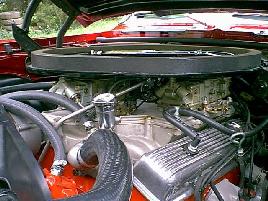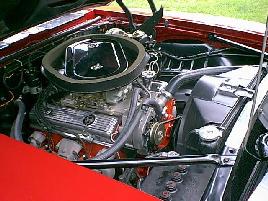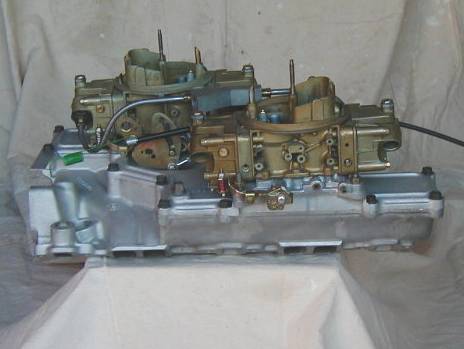| Right Front | Left Front | Left Side (off car) |
 |
 |
 |
| C R G | CRG Reports | Exterior | Engine | 1967 Model ID |
| Numbers Decode | General Info | Interior | Transmission | 1968 Model ID |
| Drivetrain Decode | Options | Underhood | Chassis | 1969 Model ID |
Camaro Cross-Ram Intake Manifolds
© 2000-2011, Camaro Research Group|
Reviewed by the CRG Last Edit: 09-Aug-2000 Previous Edit: Original Release: 09-Aug-2000 |
Dodge Dart 365 HP (273 cubic-inches)
Mercury Cougar 390 HP (289 cubic-inches)
Ford Mustang 375 HP+ (289 cubic-inches)
Chevy Camaro 403 HP (302 cubic-inches)
The Camaro more than held its own, in large part because it
had a cubic-inch edge on its competition, not to mention
being equipped with a huge, 800-cfm, four-barrel carb.
However, Product Promotion Manager Vince Piggins, Chevrolet
Engineering, and Winters Foundry wisely didn't rest on their
laurels, and proceeded to work on the development of a
double-four-barrel (2x4) intake manifold, which would help
to keep Camaro at the front of the pack in subsequent racing
seasons. With the appearance of a new, larger powerplant
from Ford (the infamous "tunnel-port" 302) in 1968, and the
new AMC Javelins with their twin-four-barrel-equipped 290s,
this was a wise decision.
Since GM had banned multiple carburetion from most of its
production cars, a 2x4 manifold would have to be developed
with the intent that it was to be sold as a service
replacement part. This was a valid procedure as far as the
SCCA racing sanctioning body was concerned, as long as the
parts were technically available to everyone that was
racing, and not just the factory racing teams. The intent
was to keep the racing as close and interesting as possible
and to allow the independent entries to be competitive with
the factory teams.
It should be understood then that no Z-28 was ever
factory-built with a cross-ram intake manifold. Not only was
there no need (the racing teams were officially able to use
the part without having it on the production car), but GM
edict said "this shall not be done" - period. The proof that
this was not a production item is in the assigned engine
stampings for the 302. Flint Engine and the vehicle assembly
plants would need a separate code to identify a motor
assembly with any unique components. There are no obscure
engine codes in the Chevrolet records to indicate that
anything but a single-4-barrel-equipped 302 was ever
assembled by the factory. It is possible that a dealer may
have converted a car prior to delivery, but most of these
manifolds were owner-installed.
The cross-ram intake manifold was developed for the 302
engine using knowledge obtained during experimentation on
the MK IV big-block. During the October-November 1967 time
frame, the first prototype 302 cross-ram manifolds (with
experimental part numbers) were cast. The identification of
these early manifold parts can become confusing but,
basically, the earliest bottom pieces to the manifolds had
no readily visible part number and had a large Winters
Foundry "snowflake" (foundry mark) on top of the #1 intake
runner. The later bases typically had a part number on top
of the #1 runner and a smaller version of the foundry mark.
Also, the hole for the vacuum fitting was moved from the
base in early units to the lid. A list of the cross-ram
components, taken from an internal GM specification sheet,
follows:
Qty P/N Description
--- ------- ---------------------------
1 3941124 Manifold assembly, Inlet
1 3947032 Inlet manifold gasket unit
2 3941140 Carburetor assembly
8 120368 Nut, Carburetor
2 3881847 Gasket, Carburetor
1 3942593 Pipe assembly, Fuel pump
1 3942595 Pipe assembly, Carburetor fuel
1 3942594 Manifold, Carburetor fuel
1 3942596 Pipe assy, Carb. fuel to L.H. side carb.
1 3942597 Pipe assy, Carb. fuel to R.H. side carb.
1 3941160 Rod assy, Front to rear carb.
1 3928326 Rod assy, accelerator rea[r] pedal
1 9413182 Retainer, Accelerator pedal rod
1 3941168 Cable assy, Accelerator control
1 393292 Retainer, Cable to accelerator pedal lvr.
1 3942592 Bracket assy. Accelerator control cable
1 3921617 Clamp, Accelerator control cable
1 120706 Bolt, Accelerator control cable clamp
1 9419727 Screw, Accelerator control cable to dash
2 3942584 Screw, special 10-32 x .92 socket head
2 3942587 Spacer, special
2 9416980 Nut, Carb rod to lever screw
1 3946801 Bracket, Accelerator pull back spring
1 3939748 Spring, accelerator pull back
1 3701777 Gasket, water outlet
1 3932344 Gasket, ignition distributor
1 3941132 Gasket, Manifold top plate to base
|
|
|